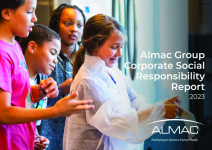PRA: get ready for the RACE Act

While the Research to Accelerate Cures and Equity (RACE) Act—a measure designed to promote pediatric cancer research and development of therapies—was enacted three years ago, it takes effect August 18. Even with the long lead time, many research entities may find themselves unprepared for the changes.
Outsourcing-Pharma (OSP) discussed the RACE Act with representatives from contract research organization (CRO) PRA Health Sciences:
- Mark Sorrentino, MD, MS, VP, Center for Vaccine Research and Center for Pediatric Clinical Development
- Martine Dehlinger-Kremer, PhD, MS, VP, Scientific Affairs, Pediatric Subject Matter Expert, Center for Pediatric Clinical Development
- Jacqui Whiteway, PhD, BSc, Pediatric Strategy Liaison, Center for Pediatric Clinical Development, Senior Director, Scientific Affairs
The experts shared the reasons for the legislation, as well as advice on how sites, sponsors and partners can better prepare for the impending requirements.
OSP: Could you please provide an overview of your perspective on the RACE Act?
PRA: The Research to Accelerate Cures and Equity (RACE) for Children Act should result in more precision medicine clinical trial options to offer young cancer patients and their families, and ultimately more pediatric oncology drugs in the pipeline that will result in improved therapeutic outcomes and decreased long-term side effects. This will be achieved by way of two notable changes to the existing PREA (Pediatric Research Equity Act) as outlined below. In essence, the RACE for Children Act does two things:
- Closes a loophole. Previously, sponsors would receive an exemption if the pediatric diagnosis had orphan drug status. Despite being the number one cause of death by disease in the U.S., childhood cancers are typically identified as a rare disease, defined as affecting fewer than 200,000 people in the U.S. The RACE for Children Act removes this exemption.
- Leads by science. Cancer is a molecular disease, which is why it is the primary beneficiary of precision medicine; however, it is often viewed or treated by regulators and the public as a disease of the organ. The RACE for Children Act mandates that it be considered on a molecular basis, as all cancer should and will be.
OSP: In particular, what are the most notable changes between this and the PREA?
PRA The RACE for Children Act was signed into law as Title V of the FDA Reauthorization Act to amend the PREA (21 U.S. Code 355c) on August 18, 2017 and goes into effect on August 18, 2020. It will impact all cancer drug development. Under the RACE for Children Act, new molecularly targeted compounds for adult cancers will need to be evaluated for children’s cancers if the molecular target or mechanism of action (MoA) of the drug is relevant to the growth or progression of pediatric cancer.
The RACE for Children Act amends the existing PREA and ends the previous exemption from PREA requirements for cancer drugs that have orphan drug status. Any new drug application (NDA) or biologics license application (BLA) submitted on or after August 18, 2020 for a new active ingredient, dosage form, dosing regimen, or route of administration, unless an exemption of this requirement was provided, must have an agreed initial pediatric study plan before submission.
Put simply, it will be standard practice for oncology drug applications to contain reports of molecularly targeted pediatric cancer investigations (unless a deferral or waiver of that requirement is granted).
OSP: In general, how has the field of pediatric oncology research, and development of treatments, evolved in recent years—or has it remained relatively flat?
PRA: It has been almost completely flat, especially in comparison to the improvement seen for conditions and diagnoses in other therapeutic areas since PREA came into effect. We’d like to say we are optimists and that improvement has been seen, especially with the upcoming implementation of the RACE for Children Act; however, we know there are some startling statistics in the field of pediatric oncology.
Currently, only 4% of the billions of dollars that are spent annually on cancer research in the U.S. are directed toward childhood cancer (National Pediatric Cancer Foundation), and that of the many drugs the FDA approved for cancer treatment in adults, only 30 have been approved for children (June, 2020 FDA website). This is despite the impact that PREA has had in encouraging an increase in treatments for other therapeutic areas and indications.
Due to these discouraging statistics, the dire need to increase not just available but up-to-date treatment options for children became evident. Doing so may give some patients with extremely poor or fatal diagnosis hope, and in the end may also lessen the debilitating late effects due to present cytotoxic therapies that befall too many pediatric cancer survivors even years after initial therapies and when they are considered cured.
Adult oncology has much more widely available molecularly targeted treatment options when compared to pediatric oncology. We need to start uniformly applying the advanced science of molecular targeted therapies to our children.
OSP: Could you share your perspective on how those changes might be beneficial, or possibly negatively impact, various stakeholders?
PRA: PRA considers patients the most vital stakeholders in clinical development. We can’t forget who the “why” is in the tireless work we do. PRA knows that many patient advocacy groups have worked tirelessly in the preceding years to have their concerns and voices heard and have brought us to where we are today with the RACE for Children Act.
Sponsors – the drug companies – have a lot to learn regarding this updated legislation and how it will impact their drug development. Each appropriate drug will have to be doubly considered and applied for adults and pediatrics. This should be perceived as a positive for patients, families, investigators/sites, and the public.
However, sponsors may well perceive this as an additional hurdle, primarily due to the burden to conduct the trials when there may be little return on investment. Obviously, sponsors would be happy to contribute to the improvement of treatments for children, but realistically there must be a return on investment, and this is not easily done according to traditional business models.
We all need to work smartly to lower burden and cost for all stakeholders. With collaborative efforts, what has not been perceived as a significant revenue generator for drug companies due to the rarity of childhood cancers may become so when cancer is more appropriately treated as a molecular disease with innovative approaches.
The need for collaboration between all stakeholders to make the RACE for Children Act a success is thus critical, and this may be seen as a challenge for some, at least initially.
OSP: You mentioned the changes could cause a “scramble” to develop pediatric study plans—could you please elaborate?
PRA: It’s all about timing. Planning ahead can be enormously helpful and sponsors should never assume anything. The FDA requires there be an agreed upon iPSP when sponsors submit their marketing authorization for a drug that includes a new active ingredient, new indication, new dosage form, new dosing regimen, or new route of administration.
Previously, many of these pediatric oncology drugs were exempt from PREA. The RACE for Children Act changes that and we expect far fewer exemptions. Once an iPSP is submitted, it can take several months for it to become agreed upon by the FDA. If the FDA doesn’t agree with it the first time, more time ensues.
The total length for review of an iPSP can be as long as 210 days. The iPSP should be initiated after the End of Phase 2 (EOP2) meeting, and many sponsors may not have this expertise in-house.
While before sponsors reasonably expected to receive a waiver, they can no longer count on that. Given the focus and commitment of the FDA to increase therapeutic options for pediatric oncology, and the time and expertise required for developing a pediatric plan, iPSPs should be planned for in advance to prevent a last-minute scramble.
OSP: How has PRA been readying its operation and preparing to help its clients and others for the RACE Act?
PRA: Here at PRA, we have been preparing for the RACE for Children Act since it was passed in 2017, so we are able to quickly and effectively support our clients and sponsors looking to conduct this research. We have brought together a highly credentialed and cross-functional team internally, including 27 board certified pediatricians and nine board certified pediatric oncologists/hematologists, to serve as hands-on consultants in the development and execution of pediatric study plans and trial conduct.
OSP: How will those changes impact pharma companies and their research partners?
PRA: We’ve tried to think of everything and continue to communicate about all the possibilities of the RACE for Children Act. We too want this new, updated legislation to go forward as smoothly as possible and with the final intent, as the FDA has stated, of bringing more pediatric oncology drugs into the pipeline and to patients.
However, we also want to be mindful that we’re not just bringing more pediatric oncology drugs into the pipeline, but appropriate ones. Due to the rarity of pediatric cancer, there may be times when certain drugs and trials will need to be prioritized; we recognize that and will help to ensure that not only will there be more trials, but the right trials for pediatric cancer.
Companies and research partners will need to embrace collaboration with each other, sites, and patient representatives. With the significant oncology pipeline but the paucity of pediatric patients, innovation and collaboration will be critical, starting in the pre-competitive space (for example, pre-clinical data and tissue repositories).
Master protocols, innovative study designs, and global studies will become more common. This requires scientific and drug development expertise and awareness of ongoing regulatory and technological developments.
OSP: Is there anything else you’d like to add that I haven’t touched upon?
PRA: Looking back at the previous question, we ask ourselves, what are the best trials for pediatric cancer research to focus on? If your child is diagnosed with cancer and given a 90% cure rate, unfortunately, that statistic doesn’t matter if your child falls into the 10% that isn’t initially cured or, worse yet, doesn’t survive. During that time, your child is the only thing that matters.
What we do know about pediatric cancer therapy today is that of those that do survive, nearly 80% will have some significant late effect, likely years later, directly related to their childhood cancer therapy. Many will even get a secondary cancer as an adult related to their initial therapy.
For some diagnoses, such as diffuse intrinsic pontine glioma, there is no cure and families are told there may be up to an 18-month life expectancy. There is so much room to do better.
Similarly, PRA is embracing human-centricity, and just as we say that it takes a village to raise a child, it will take a village to commit to curing a child of cancer.
Child death is unacceptable, and the RACE for Children Act is essentially closing a loophole (orphan exemption) and leading the scientific way for oncology to be addressed as a disease with molecular targets, not organs/tumors. We must remove the barriers for sponsors and others to show that treating pediatric cancer is not a burden, but a responsibility, and if done well – with the help of PRA – it will be profitable.














